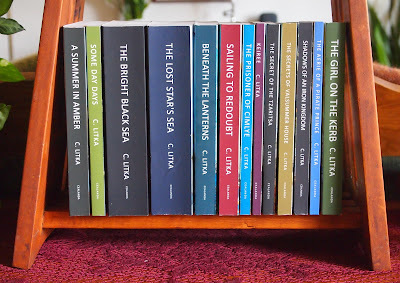C. Litka's Blog, page 30
July 29, 2023
The Saturday Morning Post (No.6)
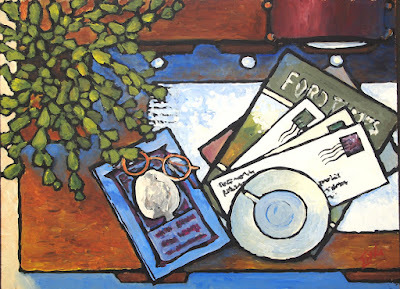
I've a grab bag of books to review this week, starting with Baroness Orczy's The Scarlet Pimpernel, which I wanted to read to see if it was indeed, Batman with swords which the Wikipedia made it out to be. Let's get right into it.
My reviewer criteria. I like light, entertaining novels. I like smaller scale stories rather than epics. I like character focused novels featuring pleasant characters, with a minimum number of unpleasant ones. I greatly value clever and witty writing. I like first person, or close third person narratives. I dislike a lot of "head jumping" between POVs and flashbacks. I want a story, not a puzzle. While I am not opposed to violence, I dislike gore for the sake of gore. I find long and elaborate fight, action, and battle sequences tedious. Plot holes and things that happen for the convenience of the author annoy me. And I fear I'm a born critic in that I don't mind pointing out what I don't like in a story. However, I lay no claim to be the final arbitrator of style and taste, you need to decide for yourself what you like or dislike in a book.
Your opinions are always welcome. Comment below.
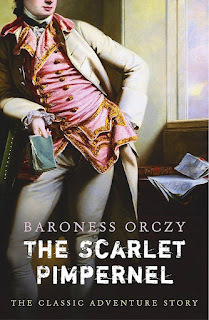
The Scarlet Pimpernel by Baroness Emmuska Orczy Orczy C+
Let's address the elephant in the room, this proved not to be Batman with swords. Indeed, not only does the title character play only a minor role, on stage anyway, in most of the story, but there is not one sword fight, indeed, not one fight scene at all. So what is the story about? Well, the Wikipedia entry states;
The novel is set during the Reign of Terror following the start of the French Revolution. The title is the nom de guerre of its hero and protagonist, a chivalrous Englishman who rescues aristocrats before they are sent to the guillotine.... (who is) a formidable swordsman and a quick-thinking master of disguise and escape artist. The band of gentlemen who assist him are the only ones who know of his secret identity. He is known by his symbol, a simple flower, the scarlet pimpernel.
Luckily for me, I did not reread this summery before I read the book, so I forgot who they identified as the Scarlet Pimpernel, (I've edited it out for you) and so I learned who it was, more or less as the Baroness intended, though before it was actually revealed. That made the story a bit more interesting. My advice forget the summery in its entirety, as it does not describe the book in any meaningful way.
The story is largely set in 1792 England, and the main point of view character is a former French actress, Marguerite Blakeney (nee St Just), the wife of a very rich and very oafish English aristocrat Sir Percy Blakeney - though it takes a couple of chapters of set up to get to her and Sir Percy who is an intimate friend of the Prince of Wales, i.e. one of the in crowd. Their marriage has fallen on ill times, though Sir Percy treats her with great respect, he would seem to have ceased to love her, and she him.
The plot centers around Marguerite, whose dear brother, is working with the Scarlet Pimpernel to smuggle aristocrats out of France during the reign of terror, even though he is both French and not an aristocrat. Indeed, having been beaten to a pulp for sending a note to the aristocratic girl he loved, he is a believer in the revolution, but feels that it has perhaps gone too far. In any event, his involvement with the Scarlet Pimpernel is discovered by a French agent in England and is used to blackmail Marguerite into helping him discover identity of the Scarlet Pimpernel and capture him while he is in France, as he rushes to save Marguerite's brother and the French aristocrats that the Marguerite's brother went back to France to help escape as part of the Scarlet Pimpernel's gang of helpers.
After the introduction of the setting and characters in the first couple of chapters, the story revolves around Marguerite's struggles to save her brother at the cost of betraying the identity of the Scarlet Pimpernel, and then her attempts to save him herself. It is rather overwroughtly written by today's standards, but I enjoyed it, even though it was not what I expected. I believe that there are something like 19 novels concerning the exploits of the Scarlet Pimpernel and members of his band of adventures, so maybe they include some sword fights. At least several are available from the Gutenberg Project where I downloaded my version of the story, so I might give them a try some day. We'll see.
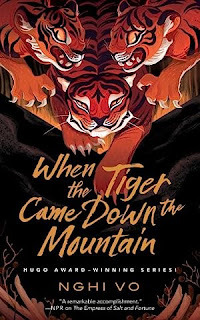
When the Tiger Came Down the Mountain by Nghi Vo C+
This is a fantasy novella set in a fantasy version of China with were-animals, in this case weretigers. The story concerns a traveling cleric/scholar Chih who is escorted to a way station in a snowy mountain pass by a Si-yu, a scout who rides a mammoth. At the station they are confronted with three weretigers who intend to eat them, and Chih must tell his version of a love story between a human and a weretiger to the weretigers who, in turn, have their own version of the story to relate, in order to keep the tigers from attacking and eating them. Each learns from each other different aspects and different attitudes of the characters and the story as they knew it. It is a quick read of 80 pages, and is set in a world first introduced in her novel, The Empress of Salt and Fortune, and now includes a second novel, Into the Riverlands. I believe Chih is the central storyteller who links all the books of the Singing Hills Cycle of which Mammoth at the Gates will be the fourth. While I can not say for certain, since I have not read either of the other stories, I suspect that this series may follow the blueprint of Ernest Bramah's Kai Lung stories set in a fictional China that have Kai Lung relating stories to bet himself out danger, but I could be entirely wrong.
I have this story only because it was one of the free books TOR.com offered, no doubt to promote Into the Riverlands when it was released. In any event, if you like weird tales of sort of China with magical creatures, then you should like these books.

John Burnet of Barns, A Romance by John Buchan C+
This is Buchan's second novel, written when he was 23. It is a historical novel largely set in 1680's in the low lands of Scotland, with a brief section in Holland. This was a time of great religious strife in Scotland between the Scottish Calvinist dissidents and those upholding the official state religion of the Church of England and it saw the king's soldier hunting down these diehard dissidents for treason. The hero of the story, John Burnet falls afoul of his elder cousin, and after besting him a duel in Holland where the cousin was a captain in a band of mercenaries. On the cousin's return to Scotland where he pursues John's true love and spreads lies that has John branded as a traitor. John returns to Scotland to save his love and clear his name.
There is nothing Buchan likes better than describing the scenery of Scotland, and having his hero a hunted man, gives him great scope for doing so. He also paints a vivid picture of the time and place with a story filled with desperate action. A fine, authentic historical novel written in the style of 1898 if that's to your taste.

The Half Hearted by John Buchan D
This is Buchan's fourth novel, written when he was 24 and tells the story, in two parts, of a very accomplished upper class young man, heir to an estate in Scotland, Lewis Haystoun, who doesn't fit in with modern society. He is not driven, too good natured, doesn't know what he wants to do with his life and so is unable to commit to anything with his whole heart. The first part of the story, relates an ill fated romance, where his indecision, and in his view "cowardice," prevents him from wining the girl he loves, and who loves him as well, plus losing an election to parliament. The second half sees him traveling to the frontiers of India and foiling a plot to invade and start a native uprising there.
I have to feel that Buchan had ambitions for this book to be "important", since he spent great deal of words expounding on his philosophy of live by putting the words into the mouths of his various characters. Buchan, was a brilliant person, the son of a Scottish church minister, he won scholarships and awards, graduating from Oxford and going on to become the private secretary of a high British government official in South Africa for three years before returning home to become the editor of the Spectator Magazine and write more novels. He ended up governor general of Canada in the late 1930's. All the photographs of him I could find all show a tight lipped grim looking man. Thinking back, I have to admit that most of his books have a great deal of "intellectual" weight to them and that his heroes all tend to be the type of people that George MacDonald Fraser's Flashman would think fools; upper-class, idealistic, self sacrificing, very pro-British Empire, foolishly brave fools and knaves who built and maintained a colonial empire for several hundred years. At the end of the story, his half heartedness lost in his determination to save the British Empire in India, Lewis Haystoun becomes one of them.
I found the story a bit too "important" and ended up skimming a lot of book two of the story as it contained a lot of talk, long descriptions of the landscape and everything the hero did, as well as social comments that are long out of date. Plus the "threat" to the British Empire seemed too silly for me to take seriously. In short, I would not recommend this Buchan story to modern readers. His best one is The 39 Steps, and if you like the hero of that one, he appears in three more books written over several decades.
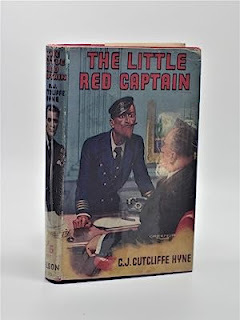
Honor of Thieves by C. J. Cutcliffe Hyne B (Republished as The Little Red Captain)
I found this book on my ebook reader, and while Hyne is one of my favorite writers, it didn't ring a bell - until I started reading it. It proved to be the first Captain Kettle story, a book I had read in paper many years ago, so my read turned into a reread.
I should say right at the start that if you are sensitive to racism, racist stereotypes, and nationalities referred to in the most demeaning terms, save the English in print, you should steer well clear of the Captain Kettle stories. The character of Captain Kettle is that of a tough, sharp tongued tramp ship officer who has to deal with crews that are composed of hardboiled characters, and does his job by ruthlessly dominating them with sheer will power and a belief that the English race is superior to all other races and nationalities. He makes that clear in how he treats everyone not English, white or not, at least in words, if not action. I do not know how much of the racism is a reflection of Hyne's attitude and how much is his effort to make his character authentic. In any event, I can accept this attitude as a reflection of the time in which it is written and the type of character the story centers on. I think it's an accurate portrait of the racism of 1895 and take heart in the fact that while we still a long ways to go for all people to view all people as one people, this type of book illustrates the fact that progress is being made, if not as fast as we would like.
The story involves a shipowner, Theodore Shelf, whose business is going under, in part due to the extravagance spending of his wife. She is bent on climbing the social ladder by having him made a peer. He meets a well educated and well traveled man, Patrick Onslow who knows of an undiscovered river where a ship may enter the Florida everglades, which in 1895 was a wilderness still inhabited by Indians, alligators and mosquitos. Onslow proposes to use this discovery to offer hunters access to the everglades using a ship as a home base, and then sell the land to would-be orange growers. Shelf, needs more money than that, and quicker, so he proposes another plan involving faking the sinking of one of his ships for the insurance money on the ship and its cargo. Captain Kettle, with an undeserved bad reputation, is hired to oversee the dirty work.
In this story Captain Kettle is a supporting character, but after this story was first published Pearson's Magazine, in an English monthly literary magazine, the editors asked Hyne to write more stories featuring Captain Kettle, which he did over the next few year, and continued to do so for until 1938, along with stories featuring a number of other nautical characters.
Coming next week, a review of two books by British writers of humorous stories and novels along with a brief discussion of how and why humor works and doesn't.
July 26, 2023
35,301 Paintings (And Counting)
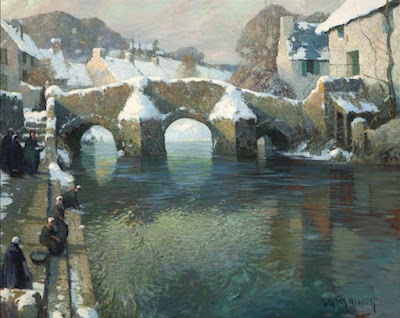 A painting by George Ames Aldrich
A painting by George Ames AldrichThere are two things I've always enjoyed doing, painting, and writing stories. I've done both of those activities off and on for most of my life. I have a closet full of paintings, at least 1500 of them of various sizes and styles, that are worth millions of dollars, if my kids play their cards right once I'm dead. (See Upton Sinclair's Lanny Budd books.) Alas, over the last five years my output of paintings as diminished to the point were I was only painting covers for my books, and that only begrudgingly, and not very well, either. With my story writing seemingly winding down, I'd like to get back into painting, and to that end, I've been surveying the world of art to get that set of creative juices flowing once again.
That survey of art has taken the form of watching slide shows of paintings from the vast collection of the Learn from Masters video collection of paintings. It includes work from over 800 painters, some of which are represented by only several dozen paintings, while others have hundreds or more. Each painting is shown for something like 6 or 7 seconds, though you can pause the video if you care to to study a painting longer. I, on the other hand, am only trying to get an overview, a feel for art again, and perhaps absorb in some intuitive manner what works and what doesn't, so I play the videos at 2X speed, viewing each painting for only 2 to 3 seconds. Some painting deserve a lot more time and attention, and others, less, I'm not trying to study art, but experience it. So far I've viewed 35,301 paintings from a mere 260 different artists.
Ideally, the paintings would be arranged chronologically so that you could see the evolution of the artist. But given the sheer number of paintings this person has assembled, I'll not complain that they are in rather random order. It would be nice if they were titled, but again, given the sheer numbers... The other problem inherent in the presentation is that all the paintings are more or less the same size. A painting could be 7 inches wide or 7 foot wide and both would appear to be the same size on the screen. This is unavoidable. However, since both finished paintings and small field studies are presented in more or less the same size, it is sometime difficult to know what the artist intended the painting to be. Was the artist painting in an impressionist style, or are we're seeing just the preliminary plein air painting made on the scene for use as a reference in producing a finished work completed in the studio. Below is an example of what I believe is a study:

And here is the finished work:
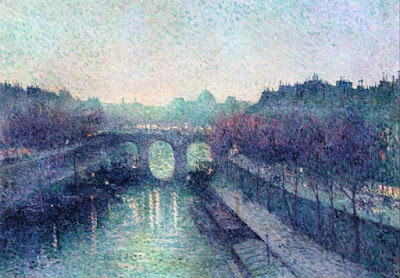 Both painting by Maximilien Luce
Both painting by Maximilien LuceSometimes the paintings are clearly quick studies for a larger work, but sometimes they stand on their own as a completed painting. In the case above what appears to be the study was shown in the presentation after the finished one, but close enough in the series that I recognized it as more or less the same painting I'd seen earlier. When you can see both the study and the finished product, you can see how a painting is developed.
I have a number or art books on impressionist painters, so every now and again I'll come across a painting from a less famous artist that I recognize. Plus it is nice to see more than one example of their work to judge them by.
I am a landscape/cityscape/seascape sort of person, so those are generally my favorites, but I do enjoy seeing portraits as well, especially when well executed. and there are plenty of them in many collections. And because these paintings can date back something like 200 years, they offer the viewer an authentic glimpse of the life of the people of bygone eras, as well as taking the viewer to exotic locales, some real, other imagined.
Here are some other things I've learned so far.
There are a lot of paintings and a lot of artists. With 800+ artists, there could be a 100,000 paintings to view.
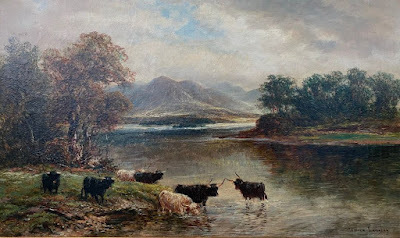 Kylie Cows Watering by William Langley
Kylie Cows Watering by William LangleyCows are aquatic animals. Many of the old landscapes that have lakes also have cows knee deep in them. Who knew?
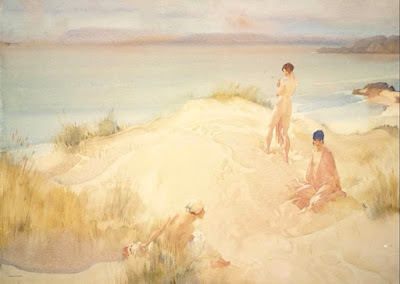 Watercolor by William Russell Flint
Watercolor by William Russell FlintIt seems that it was common for young women to gather and skinny-dip. Or so a lot of painters would have us believe. I suspect this was either wishful thinking or a fringe benefit of being an artist. What a racket.
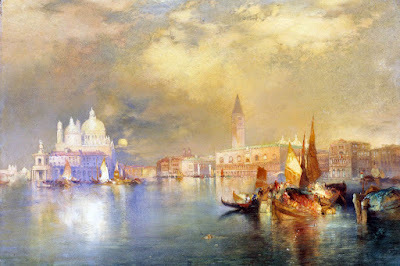 Grand Canal Venice by Thomas MoranEvery painter, it seemed, painted Venice.
Grand Canal Venice by Thomas MoranEvery painter, it seemed, painted Venice.
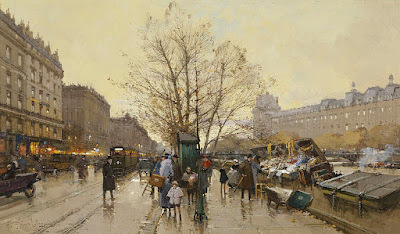 Docks of Paris Les Quais by Eugene Galien-Laloue
Docks of Paris Les Quais by Eugene Galien-LaloueAnd Paris.
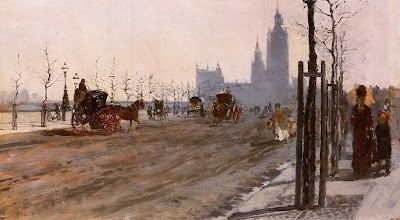 London by Giuseppe de Nittis
London by Giuseppe de NittisAnd London. Which is fine, they are interesting places.
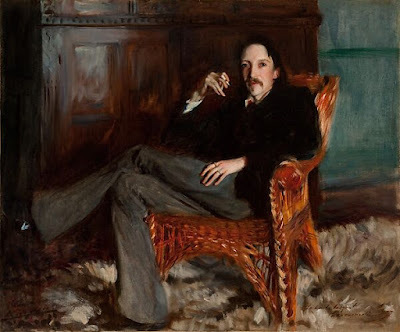 Robert Lewis Stevenson by John Singer Sargent
Robert Lewis Stevenson by John Singer SargentMany, if not most artists, painted portraits. I suspect because those commissions paid the bills.
 Benefits Supervisor Sleeping by Lucian Freud
Benefits Supervisor Sleeping by Lucian FreudMany, if not most artists, painted nudes. It was considered classic "art." Right. As I said, quite a racket.
There are, indeed, such things as masterpieces. Many times when going through a collection I will come across one or two paintings that just seem to stand out from all the rest - a combination of the right scene, lighting, colors, and execution. They are, however, rare, which is what makes them masterpieces.
I should've been taking notes, but I didn't, and now it's too late now.
Some people keep track of how many states they visit, or foreign countries. I'm going for how many paintings and drawing I've viewed.
In addition to these paintings, I'm currently up to date on installment no. 98 of Pete Beard's survey of forgotten illustrators that you can find here. In each of these segments he highlights the work of 4 illustrators in each 15 minute or so installment. I haven't counted how many pieces he shows, as it varies according to the amount of source material he has to work with, but between them and the special shows of a single artist or style, they could easily add another 5,000 paintings and drawings to my total.
Illustration for books and posters is another facet of art which I find fascinating. In many cases, I really like the illustrator's approach to a subject, though I like some countries' illustrators more than others. As I said, all fascinating stuff.
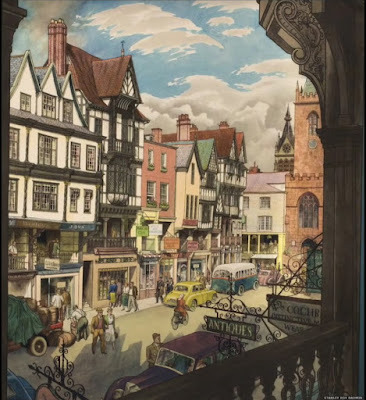 Stanley R Badmin advertising art
Stanley R Badmin advertising artWe'll have to see if it pays off.
July 22, 2023
The Saturday Morning Post (No. 5)
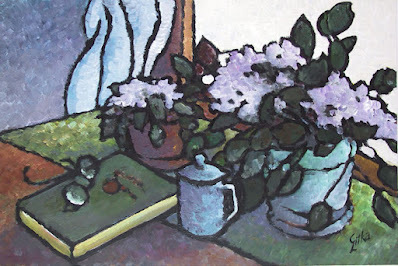
This post offers two more reviews of the books by British woman from the Furled Middlebrow collection; the best, and the most disappointing of the lot. Let's start with the most so-so book of the lot and finish with the best, but first my customary disclaimer...
My reviewer criteria. I like light, entertaining novels. I like smaller scale stories rather than epics. I like character focused novels featuring pleasant characters, with a minimum number of unpleasant ones. I greatly value clever and witty writing. I like first person, or close third person narratives. I dislike a lot of "head jumping" between POVs and flashbacks. I want a story, not a puzzle. While I am not opposed to violence, I dislike gore for the sake of gore. I find long and elaborate fight, action, and battle sequences tedious. Plot holes and things that happen for the convenience of the author annoy me. And I fear I'm a born critic in that I don't mind pointing out what I don't like in a story. However, I lay no claim to be the final arbitrator of style and taste, you need to decide for yourself what you like or dislike in a book.
Your opinions are always welcome. Comment below.
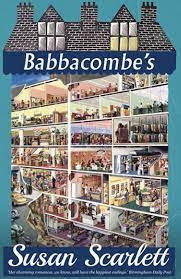
Babbacombe’s bySusan Scarlett C
Each of the 72 books Furrowed Middlebrow they havepublished feature anintroduction by Elizabeth Crawford describing the author, their work, and thenovel at hand. In this case we learn that, Susan Scarlett is the pen name of NoelStretfield (1897 – 1986) a prolific writer whose 40 year careerspanned several genre, including children’s novels in her own nameand pen names.
Thisstory concerns the Carson family, with a focus on Elizabeth Carson,the eldest daughter. Mr Carson has been employed at Babbacombre’sdepartment store, and with her graduation from school, Elizabeth starts her first job there as well. Unfortunately, they were askedto board an orphaned niece of Mr Carson, the daughter of ahalf-brother that he could not stand. She turns out to be veryunpleasant as well, nevertheless he gets her a job at Babbacombre’s as well. She chooses to be an elevator operator, as it is an easy job, thoughwithout a future, but she has a private income of sorts, so she doesn’tmind. You see, she has no intention of working all her life when there arerich men to be found.
Iopted to try this one largely based on the cover, a cutaway of adepartment store, thinking that a lot of the action would take placein the workplace, but alas, that wasn’t the case. This was adisappointing book. I found the domestic problems were toosoap-opera-ish, too melodramatic to really care about. The family came off as toogoody-two-shoes. The spoiled cousin remains too much the unredeemable snake inthe family's bosom, always looking to shove a stick intoBeth’s romance. And just to amp up the stakes, we have Beth’syounger brother going blind with cataracts (a big deal, involvinga dangerous operation in 1939, I gather). All in all, a little tooover the top for me, who likes things understated.
And now, my favorite book of the lot.
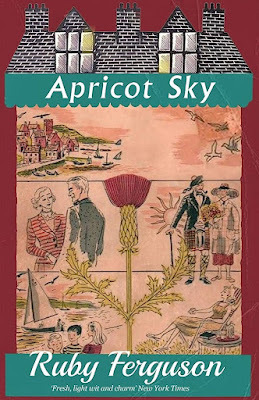
Apricot Skyby Ruby Ferguson A
Apricot Skyis your $2.99 ticket to a delightful summer holiday in thenever-neverland of Scotland’s western coast of 1948. You will bestaying at Kilchro House, with its large garden and sweeping views ofthe Western Islands in the golden sun and cool mist. You will beguests of Mr & Mrs MacAlvery, their two daughters, Cleo, justhome from three years in America, and Raine, recently engaged tomarry the 28 year old Ian, the younger of the Garvine brothers, theelder being Neil (age 30), the Laird of Larrich, plus their threeorphaned grandchildren, Galvin (age 15), Primrose (age 14), andArchie (age 10ish), as well as the household staff of Mysie, themaid, Mrs Mortimer, the cook, and Miss Vannah Paige who arrived in1917 when Mr MacAlvery was in France and has stay on for twenty oneyears, seemingly unchanged. Oh, and you’ll meet a host of otherguests, family friends, neighbors, and other characters and share intheir minor alarms and excursions during a golden summer in theHighlands – from boat trips to the islands, shopping expeditions,visits from and to the neighbors, and of course the marriage.
Ruby Ferguson fondlypaints a lush view of the Scottish Highlands, with vivid sense ofplace, as well as deftly bringing to life all the various characters,both major and minor with a friendly, but witty eye to detail, brightand breezy dialog, and a light, sarcastic sense of humor. What I loveabout her writing, and that of Molly Clavering is the fluidity of it.It simply flows, carrying you along through the seemingly mundaneeveryday life of her characters with wit and charm. Ruby’s bookjust edges out Molly’s in my ratings because of the wickedly cleverhumor she sprinkles in her story. I have to say that while I am surethere are American authors who can write as well as British authors,I can’t think of any at the moment. (I count Chandler as British,since he was educated in England, and I have to believe that theireducation is what makes the writer, at least it did 100 years ago.)
Ruby Ferguson wasborn in 1899 and read English at St Hilda’s College, University ofOxford. She wrote detective stories for magazines and 8 mystery booksbefore marrying at 35 and turning to romantic novels writing 11 ofthem, plus 10 children books about horses and a memoir. None of herother adult novels seem to be in print, which, if they are anythinglike Apricot Sky, is a great shame.
Apricot Sky issimply a wonderfully entertaining book. Highly recommended.
There are plenty more books by women authors of the last century to sample, but I think it is time to move on for awhile. Up next will be three books that I've downloaded to my Kobo ebook reader from the Gutenberg Project, which is to say more old books, starting with Baroness Orczy's The Scarlet Pimpernel. Is it "Batman with swords?" Plus one fantasy novella that I got free from TOR.com, no doubt promoting the new release of a book by the author in question.
July 19, 2023
The Co-Op Short Story
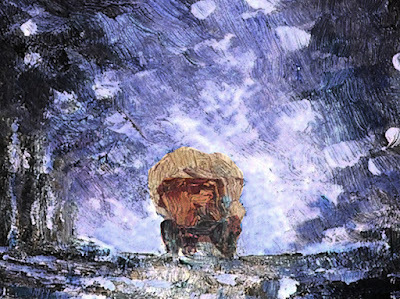
This year I managed to enter Beneath the Lanterns in the 9th edition of the Self Published Fantasy Blog Off. Last year I somehow missed the date, and this year the 300 slots were filled in something like 47 minutes. My book will be judged by the team from Timy - Queen's Book Asylum. Timy, on her blog, offers her contestants five options to be creative and highlight themselves and their books over the course of the contest. I choose the "To be continued" option which involves co-write a short story with three other writers. Each of us are assigned one of four slots in the story to be written in sequence, and we don't know who the other writers are so we can not discuss the story before hand. I thought that it would be an interesting challenge, while at the same time, being something I'd be more comfortable doing, than say throwing a fictional party for my characters, or getting stuck in a familiar book, or writing a character into a magically locked room. I'm not that creative.
I was assigned the third slot in a story tentatively titled Jesting with a Cold Soul, and the writing prompt was "illusion and dream in a carnival setting." Each section should be 500 to 1,000 words long, but you can go longer. Being both a novelist, not a short story writer, and someone who won't use one word where two will do, I ended up writing close to 2,500 words.
Luckily for me, the first author chose not to set the story in an actual magic/fantasy carnival with evil carnies and sinister clowns which is very much not my thing. Instead they went in a grimdark direction, making the carnival into a small band of, I suppose, mercenaries/bandits who dress up like jesters, and starts the story with their carts arriving at a small village to kill, pillaging and rape. Not my type of either, but that was always going to be the challenge.
In the first two parts of the story a fellow named Trisfan, one of this band of jester-murders, in recalling his own youth, ends up killing a fellow member of the band, named Jackal, in order to save a young boy from a fate similar to his, i.e. being taken into this band of killers and being unable to escape. He lets the boy flee, but this deed is observed by the band's leader, the Mad Master. Fearing retribution, Trisfan runs away, only to end up exhausted, back in the very village that they had just sacked, with the Mad Master waiting for him. This is the point where my part begins.
Grimdark is pretty much the opposite of what I write, and being halfway through the story already, I wasn't about to steer it in any other direction, though I suppose I could've if I was creative enough. Instead, I decided just to go with the flow of the story, which as I read it, Trisfan wants to escape, but is bound by some sort of magic that keeps him tied to the Mad Master.
I had him bound to the Mad Master by a magic amulet. Given the murder of Jackal, he decides that he has nothing to lose by attempting to kill the Mad Master as well. He attacks, a brief sword fight and then they fall to the ground wrestling. As they do so, one of the gang, the Mad Master's toady, attempts to end the fight by striking Trisfan in the back with his sword, but with a last second change of position, he ends up killing the Mad Master instead.
With the Mad Master dead, the remaining mercenaries need to select a new leader. Deadeye and Jackal are the two most likely candidates, but of course Jackal is dead, though only Trisfan knows this since the Mad Master is also dead. They all get drunk and eventually drift off to sleep while they await the return of Jackal. All except for Trisfan, who having decided to take his leave of the band, now possessing the amulet that bound him, decides to take along with the Mad Master's iron box filled with the band's earnings to establish a new life as well. When everyone else seems asleep, he sneaks into Mad Master's caravan, finds the treasure box and just as he is set to leave, discovers Deadeye waiting for him, wanting the treasure box for himself. This is where I end my part of the story.
We'll have to see how the final writer ends the story. I know how I would've ended it. I'd have Trisfan get the drop on Deadeye, and kill him. Then deciding not to leave potential enemies behind, he'd silently cut the throats of all his other companions as they sleep, save for the two servants who they employed to drive the caravans, make camp and cook, etc. He would then have these servants hitch up one of the caravans and then set off for the city to reinvent himself with the the treasure. The story would end with the two servants, Nog and Bog, conversing. Nog; 'He wasn't born to be hanged.' Bog; 'Nor lose his head on the block.' Nog; 'Or be drawn and quartered in the town square.' Bog; 'Or die of old age.' Nog; 'Really, having your throat cut in your sleep is such a peaceful way to die.' Bog; 'He should thank us, alas, but I doubt he will.' Nog; 'Not in his present condition, anyway.' They shake their heads sadly. Bog; 'Oh well, virtue is its own reward. Let's dump his body and be on our way. We want to be in the city by morning to get our gold safely into the bank.'
Hardly the most surprising or original twist, but a twist nevertheless. That said, in my opinion, all short stories are just set ups for the twist at the end. This is why, with few exceptions i.e. the stories written by Wodehouse, (Bertie & Jeeves) Doyle, (Sherlock Holmes) or Gilpatric, (Glencannon), I dislike short stories. They seem to me to be mostly gimmick, a mere set up for a clever(ish) twist. However, this ending is only my unofficial ending, we'll have to see how the final author finishes up the story. That will be sometime in August. I'll let you know, and post a link when it is published.
As a side note, I have to say that after writing just part of this short story, I really appreciate my use of the British style single quotation marks, i.e. 'quotes' rather than the usual quotation marks "quotes" since I found having to always hit the shift key for every damn quotation mark to be not only a real annoyance, but a likely carpel tunnel generator.
My own books:
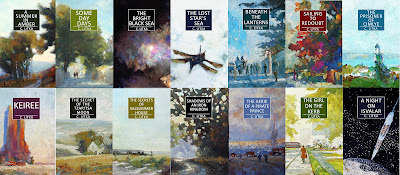
July 15, 2023
The Saturday Morning Post (No. 4)
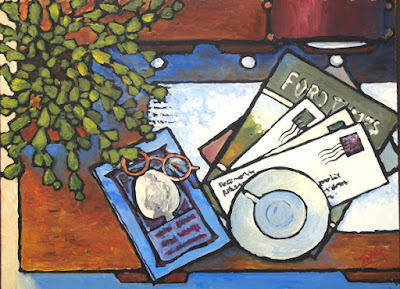
This post is the first of two where I review novels written by British women authors who are largely - but not entirely - forgotten today.
All the books are published by the Furrowed Middlebrow via Dial Press and are available as ebooks and trade paperbacks. I came across them by the Furrowed Middlebrow Blog that was listed on yet another blog, and I was curious enough to investigate their catalog of books - some 72 of them - and go on to read some sample pages on Amazon. They publish a good number of D. E. Stevenson books, an author who I have read and reviewed already on this blog. However it was Molly Clavering who I happened to sample first because her stories were set in Scotland, and liking what I read, I actually purchased one to read. Having enjoyed that title, I've gone on to purchase seven more titles of hers plus two other authors so far. I've sampled several more titles, but they did not quite intrigue me enough to get me to hit buy button, however I will likely be returning to this collection at some point in the future to see what else I can find, since for some strange reason, I very much enjoy this type of story.
My reviewer criteria. I like light, entertaining novels. I like smaller scale stories rather than epics. I like character focused novels featuring pleasant characters, with a minimum number of unpleasant ones. I greatly value clever and witty writing. I like first person, or close third person narratives. I dislike a lot of "head jumping" between POVs and flashbacks. I want a story, not a puzzle. While I am not opposed to violence, I dislike gore for the sake of gore. I find long and elaborate fight, action, and battle sequences tedious. Plot holes and things that happen for the convenience of the author annoy me. And I fear I'm a born critic in that I don't mind pointing out what I don't like in a story. However, I lay no claim to be the final arbitrator of style and taste, you need to decide for yourself what you like or dislike in a book.
Your opinions are always welcome. Comment below.
As I you have sees in my statement above, I like small stories with pleasant characters, and for some reason these little stories of everyday life in Scotland and England in the first half of the last century appeal to me.
In this first installment, I'm going to review books by Molly Clavering, the first two written under her early pen name of B. Mollett from 1936 & 1939.
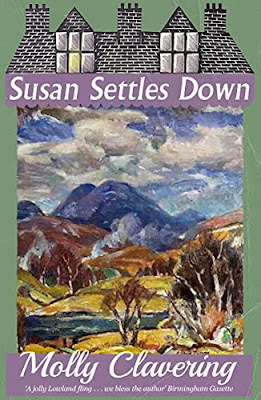
Susan Settles Down by Molly Clavering B+ (Writtenas B. Mollett)
Writtenin 1936, it is the story of Oliver, an ex-Royal Navy officer with aleg smashed in a car crash, inherits a rundown manor in the Scottish Border lands, and of his mid-30’s single sister, Susan who keeps house for him, which in the case of many of these books, means overseeing the cook and maids who do the actual housekeeping. In the course of the story we meet the local residences,get a glimpse of the tide of life in that age in rural Scotland, andwatch several tentative romances weave their way through thenarrative. In short a light little novel, the type of story I like – a quiet,relatively realistic understated romance set in a lushly, andlovingly, described countryside. Miss Clavering was a neighbor andgood friend of D E Stevenson, whose books, as I mentioned, I’ve read decades ago. I actually paid money forthe digital copy of this book after reading the free sample ofanother book which I will be reviewing shortly.
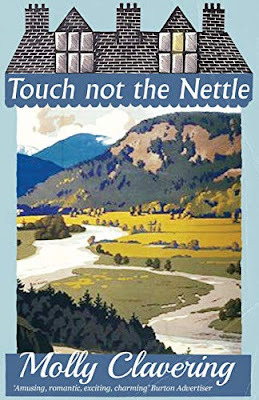
Touch Not the Nettle byMolly Clavering C + (Written as B. Mollett)
Thisstory is a return to the locales and characters in Susan Settled Downwritten several years later in 1939. It introduces several newcharacters, the local Heriots, brother Larry and sister Ruth, tworather unpleasant people, and Amanda Carmichael, the possibly widowedshirttail relative of Susan’s husband Jed, who they take in helpher to escape her domineering mother while she awaits word about thefate of her husband, an aviator whose plane disappeared, and isthought to have crashed in the Brazilian jungle. We learn the state of Amanda’s marriage, and the reasons behind the unpleasantness ofthe Heriots. I did not like this one quite as much as the first book,perhaps because it had some unpleasant characters.
The next four Clavering books I read werewritten between 1953 and 1956, and they are much more mellow books,with older protagonists. These early books I think are still slice oflife stories, but have some mildly melodramatic elements, and moreconflicts. Though there are two more of the "B. Mollett" books fromthis era that are available, their blurbs don’t appeal to me, so Ithink I’ll pass on them for now.
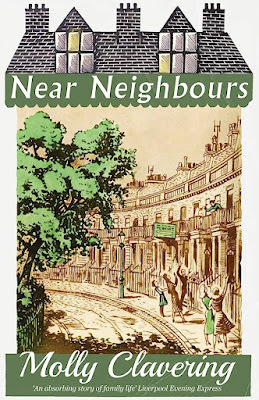
NearNeighbors by Molly Clavering B+
Ican’t for the live of me say why I find these little domestic sliceof life stories so delightful, as a character in these stories mightexclaim. But I do. And always have. Decades ago I read all of theMiss Read books I could find in the library, as well as most of D EStevenson’s books, plus a number of similar but more contemporarystories set in the America. Moreover, as I mentioned in the intro, I have always been fascinated by life inEngland in the first half of the 20th century, be it theFu Manchu stories of Sax Rohmer, the London books of H V Morton, thecomic stories of P G Wodehouse, and the adventure stories of JohnBuchan. And in similar vein, the Cape Code stories of Joseph Lincoln. I just find them more engaging than sprawling epics withworld shattering stakes, just as I would much rather read a historybook entitled “Every Day Life In…” than a book that focused onkings and queens, princes and knaves, generals, wars, and politics.Go figure.
Thisstory is set in Edinburgh post WW2. The main character, Dorothea is a68 year old spinster whose domineering elder sister has just died.Over the years she has watched the comings and goings of the neighborfamily, a widowed mother, four daughters, (one married with theyoungest 16) and a son. After the funeral, one of the daughters seesDorothea in the window and decides to pay her a call of condolences,something she wouldn’t done when the elder sister was alive. Thisvisit is the beginning of a friendship between Dorothea and the Lenoxfamily and the affairs, love and otherwise of the Lenox family, aswell as the emergence of Dorothea as her own person.
Ifind these stories interesting in their fictionally enhanced view ofeveryday life in England. The main characters are what I supposeyou’d call upper class middle class, i.e. they’re not rich, butwell off enough to employ at least a cook, if not a maid as well. Andif they have young children nannies and nurses. Though we sometimesget a view of the lower classes as well, they are filtered through theeyes of the upper class middle class writers of these stories.
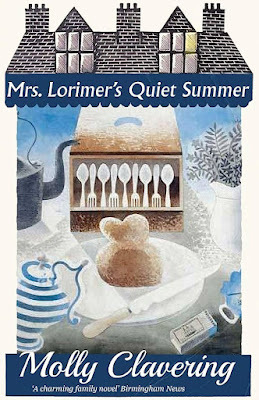
MrsLorimer’s Quiet Summer by Molly Clavering B+
Ireally like the way Miss Clavering wrote. While there is nothingidentifiable Clavering in the writing, as one could say about, say, PG Wodehouse, nor is there nothing startling about the stories shetells, they are stories about the little domestic dramas of uppermiddle class life in Britain before and after World War Two, nevertheless shewrites them with such a deft fluidity that her stories have anunderstated elegance to them. I couldn’t put my finger right on it,but I’ve read Babbacombe’s by Susan Scarlett, anovel written for the same market, and it just doesn’t have quitethe charm of Miss Clavering’s stories. Review of that book is coming next week.
Thisnovel concerns, as the title suggests, one summer in Mrs. Lorimer’slife, though it is not quite as quiet as the title suggests. TheLorimers, Mrs., a successful author, and Colonel Lorimer, now retiredand an avid gardener, have a house in the Scottish Border lands. MrsLorimer feels, with some justification, that the house too small for when all four of their children, two sons and two daughters plus theirfamilies come for a week long visit. Some of thechildren have to stay at her best friend’s house, Miss Douglas.Each of them bring with them their own problems, a broken heart, anunhappy marriage, a dreamy, un-domestic wife as well as a long lostlover, for Mrs Lorimer to try to sort out. Once again we are treatedto life in Scotland in 1950 seen through (likely) rose colored, upper middleclass glasses, which, as I’ve said I find entertaining.
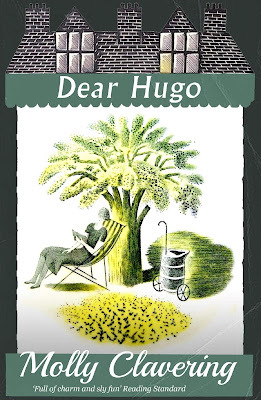
Dear Hugo by Molly Clavering B
AStory set in the early 1950’s Scottish Border lands, in the villageof Ravenskirk, likely a fictionalized version of Moffat where MissClavering lived for a time. Sara Monteith writes a seriesof mostly monthly letters to Hugo, the brother of Ivo, her love killed in WW2, who is an officer stationed in NorthernRhodesia. The letter format is just a loose framing device, and itreads pretty much like a first person narration, with just a fewasides to the recipient. Sara has moved toRavenskirk for sentimental reasons; it was the home of Ivo and his brother, she wanted to becloser to his memory. She somewhat reluctantly agrees to look after Arthur, the teenageof a cousin of hers. He is moving to the U.S. with a new wife, andArthur, having been raised with his grandparents, did not settle inwith his father's new wife and family. The story covers several years as Sara and Arthur, who is away during the school year at an Edinburgh boarding school quickly bond. As usual, it tells the story of everyday life, the people and the countryside in rural Scotland as well as the special social events around the coronation of Queen Elizabeth. And, as usual ,there is just a hint of romance.
I should note that Sara in this story is not wealthy enough to employ a full time maid or cook, but does employ a part time maid to keep her small house in shape. She is not employed outside of the home, but lives on some sort of inheritance, plus money she receives from her cousin for the care of his son. I have to wonder if the necessity of employing even part time help to keep house is a reflection of how many time saving devices we enjoy today that allow most people to keep house without help, or a reflection of the social attitude of the time; a gentlewoman does not do housework. I'll report back if I ever get a better insight into this phenomena.
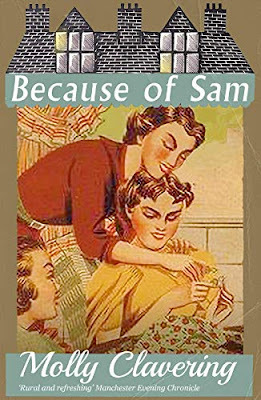
Becauseof Sam by Molly Clavering B
Anotherstory set in the Scottish Border lands of the early 1950’s, i.e. acontemporary story at the time it was written. This story featuresthe long widowed Millie Maitland who has a rather prickly daughterAmabel who is in her late 20’s and is employed in Edinburgh. Once again, Millie gets some sort of income from inheritance, but has to make ends meet by taking in dogs as boarders for vacationing people. Sam in the title being one of the dogs she looks after for a neighbor's cousin. And once again we’re given a story of everyday life in rural Scotland,its people their social customs and classes, seasons, and setting, with several traces of romancewoven through it. However, though all of Miss Clavering’s books, romanceis only a minor element. Miss Clavering’s heroines, like the authorherself, are independent women whether married or not.
Next week I will review two more books from two different British women authors published by the Furrowed Middlebrow from this time period. But until then, a period cover...
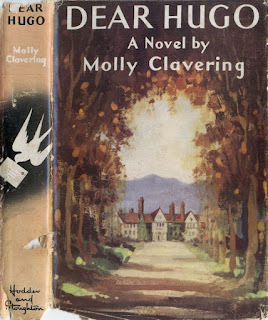
July 12, 2023
AI And the End of Everything :)

Bertieknew that Barkley needed only a hard reset to be restored to hisnormal, loving, playful self. But there his troubles began. He foundhimself situated without a paper clip and Barkley had, earlier inthe evening in what, with hindsight, seems to have taken on a muchless mischievous cast, eaten his phone.
Everyone is talking about how AI will replace all sorts of artist, including writers. I've not weighed in on the subject, until now, for the simple reason that it's a done deal. The genie is out of the lamp and the genie is not about to go back into the lamp. Railing against AI is just yelling at clouds.
Why? If there's a common thread woven into the last several hundred years of human history, it is that workers are replaced by machines whenever the opportunity presents itself. There is nothing capitalists hate more than paying workers even starvation wages. If the soft machine of AI can eliminate writers, they will do it. And AI can. The only caveat is that the process will likely take longer than one might suppose. Hell, they're still printing paper newspapers in 2023. But seeing that they've already started replacing writers with AI generated content, it is only a matter of time before almost all writers find themselves in the dustbin of history. While it will affect all sorts of writers, I'll just concern myself with writers of fiction in this essay.
While there are various legal issues that will need to be addressed in the coming years, these will be contested and settled by corporations with their army of lobbyists. The question will not be the pros and cons of AI but who gets what cut of the AI revenue. Hint: it won't be writers.
Wait just a moment, people will say. Machines can't be truly inventive or creative since those are human characteristics arising out of distinctly human thought process and experiences which are too complex for mere machines to duplicate. Or to put in another way, AIs ain't human, so they'll never be able to offer the unique human insight that humans can put into words. This attitude strikes me analogous to saying that humans are unique, and superior to every other living and non-living thing, because they have a soul. If you care to believe in souls and the specialness of humans, fine, but I don't think you need to invoke the supernatural to explain the creative process (even though it can feel like it sometimes). It is a matter or gathering and rearranging experiences, specific and vague, facts and feelings, into words which may be unique, but never entirely new, simply because those words express what the creator has experienced and read in life. Given this, I see no reason why advanced machines supplied with the vast human experience set down in words won't be able to find ways by a similar process of association to use those words creatively within a well defined structure to write new, entertaining and very human books.
And then there is the fact that a story doesn't need to be totally new to please readers and sell books. In fact, most readers aren't looking for something totally new. You need only consider at all those fictional villages where your chances of getting murdered would seem to be about one in four to realize that what most readers want are familiar stories with just enough shinny new chrome on them to make the story read just different enough from all the similar ones without breaking the expected format. Heck, these days bookshops are full of modern "retellings" i.e. recyclings of classic literature and Greek myths, not to mention all those long series of best selling books written to a proven formula to know that originality is not what most readers value most in their books
And when you consider the fact is that most commercial stories are constructed according to very specific blueprints - hero's journeys, three acts, "save the cat", etc. This type of structure would seem to be something that a machine like an AI will be designed to use and likely excel at. Human writers draw on their life experiences and what they've read and then rearrange those experiences according to these blueprints to create a new story. I see no reason why AIs cannot be designed to use those blueprints to produce stories just like humans.
If I am right, the end is in sight for a career as a writer, and as far as I'm concerned, good riddance. Clubbing baby seals to death is less brutal than the way publishers treat authors in that it's over fast. For most traditionally published "professional" writers, their career is a short, ill payed gig - a classic example of casual labor, or gig labor in today's parlance. Authors pay must 15% of their often meager pay to the agents who land them a limited project with no benefits. They are paid just several times a year, most often for what they could make working part time, with benefits, at Aldi. It is said that 60% of traditionally published writers' careers are over after three years and 90% are out in ten. I would guess that the same can be said for indie authors. Many indie authors burn out after a few years by the pace they have to produce books at.(Or their readers do.) Plus most indie authors actually lose money as publishers. Little wonder that writing drives many authors to drink and depression, making writing fiction an ideal job for a machine. And as I said, given capital's historic disinclination to employ people when there is any alternative, publishers can be counted on to replace writers with AI just as soon as they can.
Plus, we can't ignore the fact that human writers will also be using AI to produce their work as well, so even without publishers, AI work will infiltrate every aspect of writing. Indeed, I expect author generated AI work to spread like a wild fire through indie publishing because it offers the holy grail of indie publishing - a very short turn around time between books. And given the formulaic output of most best selling indie authors, the machine version will likely replace a lot of the hand-crafted stories without anyone noticing it.
However, it is not just the writers who face commercial extinction. Publishers may, if they don't adopt, find themselves in dire straits as well. I see great potential in a new type of publishing - stories on demand - personal stories. I can envision in the not too distant future apps on cell phones that are tied to large AI systems that can generate, in a matter of seconds, stories specifically crafted for the tastes of the individual subscriber. I see it as a service where customers fill out forms describing the type(s) of stories they like and the service's AI will generate custom stories for them on demand. Feed back will fine tune these stories, allowing the reader to (almost) write their own books - while still being surprised by it. Perhaps for a premium price, readers will be able to design their own characters as well for their story plots, to create their own long running series with their characters. The fact is, AI might make the reading experience better for readers, a win for readers even if it's a lose for writers.
Still, what AI can't do is to prevent writers who enjoy writing from writing. Writing is a relatively popular form of creative activity, and it isn't going away. There will be opportunities for writers, along with artist, musicians, actors, dancers, etc. who will be displaced by AI at the commercial level to earn pocket change as an artisan. They will join the wood workers, birdhouse makers, quilters, scrapbookers, and all the other arts and crafters who create their art mostly for fun and sell them at craft fairs for a modest profits. It will simply be a matter of adjusting expectations.

Expertsare unable to explain the apparent popularity of Karl Marx’s DasKapital amongst robots. Even such relatively ‘dumb’-- or‘proletarian’ as they would prefer to be called -- applianceslike refrigerators, coffee makers and toasters are fond of scrollinglong quotes from Das kapital on their status display screens. Someexperts point to this as evidence of robotic humor. Others scoff atthe very idea of robotic humor. Prof. Albert Humperdike is quoted assaying: ‘If robotic humor does exist, and I find no compellingevidence of it, I would allow that Karl Marx would be the height ofit.’
July 8, 2023
The Saturday Morning Post (No.3)
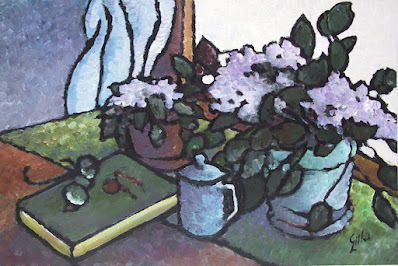
This week I have three Dr. Greta Helsing novels to discuss. These books are sort of a cross between cozy mysteries and urban fantasy, with a lot of medicine tossed in as well. Shaw takes familiar monsters from classic literature, the bible, and movies and treats them like regular, if marginalized, people. While on one hand, this is a clever elevator pitch for a story, and can be used as a metaphor for other marginalized people, it also strips from these characters their identity as monsters, demons, devils, which is to say, the thing that makes them special. It is a fine line to walk. I think if you are familiar with the literature of vampires, and classic horror as well as all the monster movies Hollywood has churned out over the years, you might enjoy the stories more than I did, who is not familiar with the stories and who last saw a monster movie some 60 years ago.
A fourth novel and a novella are slated to be released in this series in 2024/25.
My reviewer criteria. I like light, entertaining novels. I like smaller scale stories rather than epics. I like character focused novels featuring pleasant characters, with a minimum number of unpleasant ones. I greatly value clever and witty writing. I like first person, or close third person narratives. I dislike a lot of "head jumping" between POVs and flashbacks. I want a story, not a puzzle. While I am not opposed to violence, I dislike gore for the sake of gore. I find long and elaborate fight, action, and battle sequences tedious. Plot holes and things that happen for the convenience of the author annoy me. And I fear I'm a born critic in that I don't mind pointing out what I don't like in a story. However, I lay no claim to be the final arbitrator of style and taste, you need to decide for yourself what you like or dislike in a book.
Your opinions are always welcome. Comment below.
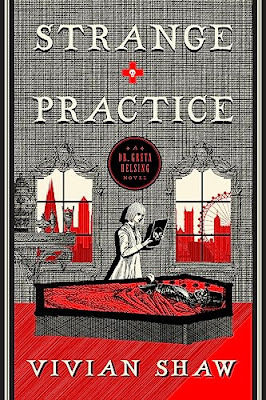
Strange Practice by Vivian Shaw C+
This is the first book inthe Dr. Greta Helsing series. The story is set in contemporaryLondon, where Dr Helsing, like her father before her, is a HarleyStreet doctor to monsters. You know, movie type monsters; vampires(famous in film and fiction), werewolves, mommies, gremlins, andvarious other familiar and unfamiliar monsters and demons. She iscalled to the home of Lord Varney, an old friend and vampire inorder to treat another famous Vampyre, one Sir Francis Varney who hadshowed up at his door, having been attacked in his flat by garlic andpoisoned knife wielding monks in brown habits, inflicting a wound onhim that he was unable to heal on his own. The story turns into asort of cozy mystery when the Doctor, and an assortment of monstersand regular people who know about them, try to track down the order ofmonks responsible for attack. Since I don’t like to go intospoiler territory, I’ll leave it there, except to say that thestory moved along, while introducing a cast on monsters and demons.
Unlike several ofthe urban fantasies I’ve read, Shaw understands that you can’thave magical things happening on any sort of scale and expect peopleto be ignorant of the existence of magic. So for the most part, the events in thisstory are low key affairs, involving only a few people who are in the know,the good monsters and the bad ones, without involving the police.However, for some reason, perhaps to raise the stakes that didn’tneed raising, she also includes an unnecessary string of 11 Jack theRipper like killings undertaken by the monks in the book.Because the good guys and monsters deal with the monks on theirown, these murders never get solved – undermining her reasonablepremise that monsters need to stay hidden for the premise to workreasonably well. She also left another thread dangling… but here Iam nitpicking, as usual. Never mind. If you enjoy urban fantasieswith likable characters and an inventive treatment of monsters, Ithink you will enjoy this book.
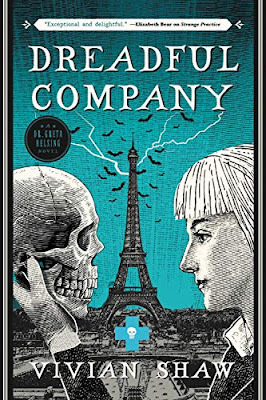
DreadfulCompany by Vivian Shaw C+
This is the secondvolume of three in the Dr Greta Helsing series. This time Dr Gretatravels to Paris for a monster medicine doctor’s conference andsoon finds herself neck deep in a cove of bad vampires. Some oldcharacters, some new characters, a little more of the magical world.I think this one was a little better than Strange Practice.But I have to admit that I found it maybe a little over wrought and,and as you can see from my grade above, there were longsections of Greta making her through underground Paris, with bits andpieces of the Phantom of the Opera tossed in, that got tedious, which I ended up skim reading.Indeed, perhaps even the author felt it was getting tedious as well, since she shiftedto another the viewpoint of Greta’s friends to have her emerge fromthe tunnels – only to then go back, and continue the trek, even after she had shown how it all ended. Curious. I just didn’t getwrapped up in the characters as much as I would’ve liked to.
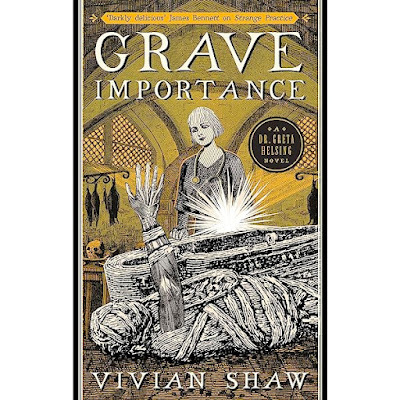
Grave Importance by Vivian Shaw DNF 85%
In this third installment, Dr. Helsing is asked to take over a clinic for mummies located in the south of France for 4 months while its medical director does something in Cairo. Many of the main characters from the first two books return in this story. In the story mummies around the world are experiencing fainting spells that can damage their frail bodies, or what is left of them. And we have agents of an alternative heaven who are working to rend the dimensional wall between their universe and ours in order to bring about the end of the world as described in the bible. Those two plot threads are linked, as we jump from those two viewpoints, and others as well, all the while being treated to an inside look at the care and treatment of mummies.
Spoilers ahead.
It was okay for awhile, but as the plot heated up and we neared the final grand climax I found that, despite my the best of intentions, I was starting to skim read more and ever more as the final crisis built to its climax - and not in a good way. I wasn't on the edge of my seat because couldn't wait to find out what happens next. Rather I found that I didn't care what happened next and just wanted it to be over. In the end, I simply gave up skipping whole pages, so I have to call this a DNF, somewhere around the 85% mark. So why did it run off the rails for me?
It starts with characters. As you can see from my review criteria, l like pleasant characters. Shaw's characters are all peasant, The problem for me is that they are, in fact, too pleasant. Something I wouldn't have thought, possible. They're all goody-two-shoes, too sappy sweet, too self sacrificing, too serious, too heroic for my taste. I mean, even the devils are polite, concerned, and helpful. I guess I never quite connected with her characters in previous books and by this book, I simply found them so sticky-sweet as to be actually annoying.
Next up is the romance elements in the story. This too, I found to be annoying, for I felt that all the romances were unearned, in that they all were love at first sight, and even months later the relationships were lovey-dovey to be rather icky. Being both a fan of romance in stories, and pleasant characters, to find myself disliking both the romance elements and the characters in a story, they'd have to have been written over the top. And I found them so. They were so sappy. So soapy. So unconvincing. Nope.
As you might have already gathered, believability, was, for me, totally lacking in this story. Take the medical practice in this story. Its main focus this time is the medical practices regarding mummies. Mummies, it seems, are mostly wrapping and frail bones, and in this story they are animated and conscious via unknown magic, as they don't even have anything like a working brain, or body for that matter. And yet Doc Helsing spends her time gluing their bones and tendons back together along with pest control for their wrappings, as if their physical condition would matter to creatures animated by magic. If these magically animated beings needed healing, magic would be the way to heal them, one would think. Didn't make any sense, except to high light Doc Helsing's devotion to caring for her monster patients. She's wonderful.
My next complaint is, well, as you recall from what I said in my review of Dreadful Company, is how I liked it that the author kept the story grounded by keeping the presence of monsters and their problems very low key, and thus, out of the public eye. This greatly contributed to my ability to suspend my disbelief concerning the premise of the story. Well, that reasonable restrain was tossed over board in this book. We have a story where the end of the world happens just as it is described in the bible,(or so I gather anyways) complete with angels with fiery swords and raining blood. I found the ending increasingly frantic, silly, sappy, soapy, cluttered, melodramatic, and simply way too too much to be even remotely believable. I ceased to care about it. Since I was skim reading and then not reading the story by the time we got to this point in the story since I can't say too much about how it all ended up, save that I gather that this end of the world somehow gets magically reversed, with a 300 point bold "No" in the text, so that in the end, all that the people of the world might remember of the climatic ending of the world, is as a strange dream. As far as I'm concerned, the series, even granting its rather silly premise, jumped the shark in this book, big time.
In the end, the gimmick of this series is making monsters into ordinary, if marginalized people. While it is a cute idea, making them so ordinary and oh, so nice, strips them of their essential character, as I mentioned previously. Take Hell for example. While a good part of this story takes place in Hell, I don't recall any mention of all the damned souls being tortured for eternity there, which is the biblical reason for Hell, even though she frames the story with the trappings of biblical mythology. Shaw makes Hell an ordinary place with some interesting scenery and portrays devils/demons as pleasant, ordinary people just like us. There are harried demon doctors and bureaucrats, pastry chefs and TV anchorpersons, all living the ordinary 21st century life just like we humans. Apparently they get sick, go to spas, watch TV, they even have cell phones with service to our world. I can see that Shaw may've been making the point that our understanding of the devil, seen as evil, just like all the monsters, has been twisted by the tellers of ancient stories. But if you are going to make them so mundane, so familiar, why bother making them devils at all? And why bother concocting some sort of vague, hand waving, pseudo-scientific explanation of Heaven(s) and Hell(s) as some sort of inter-dimensional locales when you include magical creatures and employ all the trappings of biblical stories, including angels with flaming swords and the apocalypse? She seems to be trying to have it both ways, science, magic, myths, and that doesn't work for me. The story becomes just one big McGuffin, an excuse for drama that doesn't the least matter in the end.
So, to sum up the series, while I never connected with the characters, the first two stories were interesting enough, if a bit too soap operatic for my taste. Seeing that elements in the first two stories were used to set up the final apocalypse in this last story, I have to believe that it was always her intention to have this vast melodramatic ending to the series from the get-go. Too bad. And given that five years will have elapsed between the third book and the fourth, I have to suspect that she had planned only three books. But I guess they proved popular enough that she and her publisher find that it would pay to put out several more.
In the end, thinking about it, the main problem for me was that these stories, with their pleasant monsters and loving vampires, are small, cozy adventure/horror stories, and as such, the vast, fiery world ending apocalypse fought mostly in Hell was out of character. It was just too much and in the end, it had to be dealt with by being, in essence, "just a dream" for just about everyone in the world, which is, in my opinion, a cheap cheat.
Your mileage may vary, but I can mildly recommend the first two book if you're into cozy urban fantasy, but I'd say skip the third book and wait to see what the next two bring to the table.
July 5, 2023
Batman With Swords and Magic
Batman with swords and magic; sounds like an interesting idea for a book. It's not my idea, but one proposed by fantasy author Mike Shackle on Mike's Book Review YouTube channel. When Shackle was asked what he was working on next, and he listed two story idea, one of which was "a modern retelling of Legend, with Vikings. i.e, What it would be like if Vikings were standing on the walls of Helmsley." and the other, "Batman with swords and magic." Care to take a guess as to what idea resonated with the host? If you said "Vikings on the walls of Helmsley," you've another guess coming.
Whether an author is trying to sell a book to an agent, or an agent to an editor, or an author selling books to readers as an author/publisher, they need to quickly spark their potential readers' interest using images that they can immediately translate into a vision of the story. When querying manuscripts to agents, authors are told to compare their book (i.e. "comps") to one or more recent best selling books, as in "so-and-so book but with this twist," or "it's a mash up of this book and that book." The reason given for this is that it illustrates the author's knowledge of the current market, thus giving agents some measure of confidence in the author's professionalism. This, in turn, might lead the agent or editor to actually read the sample work at the bottom of the email. The same dynamics applies to self published books as well, except that authors are using the comparisons to address readers directly, hopefully encouraging them to buy their book. So no matter what type of author one is, if an author can imagine (and write) a book with a simple, but catchy premise, they are halfway to success.
But it's more than a concept, its also a matter of how the concept is phrased. Let's take a deeper look at the "Batman with swords and magic" premise, and how the phrasing works to sell the idea. Shackle when on to mention that he had set the story in a fantasy world based somewhat on revolutionary France, to the point were people were losing their head at the guillotine in chapter one.
It occurred to me sometime later that, well, isn't there already a book like that, though without the magic? The title that struck me was "The Scarlet Pimpernel" (actually it was "The Scarlet Pumpernickle" that occurred to me, but a quick Google search lead me to the correct spelling.) So what is Baroness Orczy's The Scarlet Pimpernel about? Wikipedia says:
The novel is set during the Reign of Terror following the start of the French Revolution. The title is the nom de guerre of its hero and protagonist, a chivalrous Englishman who rescues aristocrats before they are sent to the guillotine. Sir Percy Blakeney leads a double life: apparently nothing more than a wealthy fop, but in reality a formidable swordsman and a quick-thinking master of disguise and escape artist. The band of gentlemen who assist him are the only ones who know of his secret identity. He is known by his symbol, a simple flower, the scarlet pimpernel.
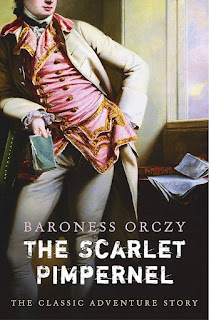
Isn't that, sans the magic, pretty much "Batman with a sword", and indeed, pretty much plain old Batman? Now I'm certain that the story Shackle would write, if given the green light, would be significantly different from The Scarlet Pimpernel, even before adding a fantasy element to it, but the story idea could've been phrased as "A fantasy retelling of The Scarlet Pimpernel" just as accurately. But would that have resonated the way "Batman with a sword and magic" did? I doubt it, because The Scarlet Pimpernel is not part of today's popular culture, and any reference to it would have fallen flat, i.e. " isn't Pimpernel, some sort of rye bread?" if anything at all occurred to the listener. To appeal to readers authors have to know them and know what they are familiar with. And if they can intrigue them with their story using a minimum of words, so much the better. Readers, agents and editors, have too many options to spend more than a couple of seconds considering and author's book, be it a proposal, manuscript, or an Amazon listing.
I've never read Baroness Orczy's story, (still, Batman with swords... I downloaded a copy from the Gutenberg Project, so look for my thoughts on it some future Saturday) so I can't tell you how I became aware of its central theme, but I suspect that being 73 years old has something to do with it. I doubt very much that a whole lot of people younger than me would've been aware of The Scarlet Pimpernel except as an old movie or TV show, since the last presentation of it was a six part BBC tv series in 1999-2000.
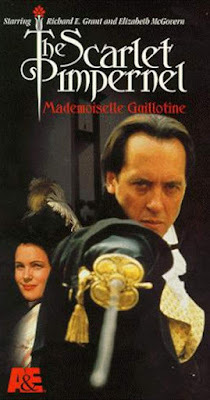
The bottom line is that if an author wishes to produce a commercially viable story, they need to write one that presents an interesting new twist on the popular premise. And this premise should be able to be expressed in a short, snappy line or two.
This, however is one of those things to do as I say, not as I do. I was unaware of comps until a few of years ago, and it never seemed to apply to me as an author/publisher. More significantly, my books are "passion projects," i.e. books I wanted to write rather than books written to sell. One of the reasons why I wrote them was that I couldn't find many contemporary books that I actually wanted to read, so I had to write my own. This means, however, that I'm not familiar with any recent books to compare mine to, even if there are recent books that I could use to compare them to. I tried. When I was writing The Girl on the Kerb, the only thing I could come up to use as a "comp" was the Hope and Crosby "Road Pictures." One of its working titles was The Road to EuraEast for that reason. However, I didn't think anyone who'd be looking at my query letter would have ever heard of those old movies, so I didn't include comps in my query letter, and changed the title of the story to something more contemporary, though with a wink of sarcasm as well.
Still, when all is said and done, success can still be found by thinking out of the box, by trusting your talent and making something unique. I wouldn't do anything different if I could do it over.
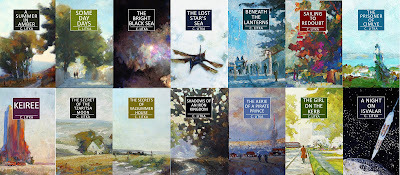
July 1, 2023
The Saturday Morning Post (No.2)
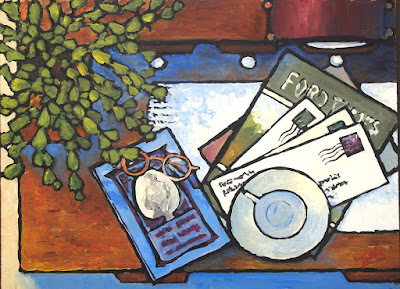
I've reread three books in June, two of them old favorites, and one from so long ago that I had no recollection of it. The first, one of the favorites, is Flashman and the Mountain of Light. I picked it off the shelf to read early in June while waiting for The Book That Wouldn't Burn to arrive from the library. The second book is John Masefield's The Brid of Dawning, a sea story that I no doubt read some 30 years ago, and remembered nothing about it. And the final one, another old favorite is Patrick O'Brian's H.M.S. Surprise.
My reviewer criteria. I like light, entertaining novels. I like smaller scale stories rather than epics. I like character focused novels featuring pleasant characters, with a minimum number of unpleasant ones. I greatly value clever and witty writing. I like first person, or close third person narratives. I dislike a lot of "head jumping" between POVs and flashbacks. I want a story, not a puzzle. While I am not opposed to violence, I dislike gore for the sake of gore. I find long and elaborate fight, action, and battle sequences tedious. Plot holes and things that happen for the convenience of the author annoy me. And I fear I'm a born critic in that I don't mind pointing out what I don't like in a story. However, I lay no claim to be the final arbitrator of style and taste, you need to decide for yourself what you like or dislike in a book.
Your opinions are always welcome. Comment below.
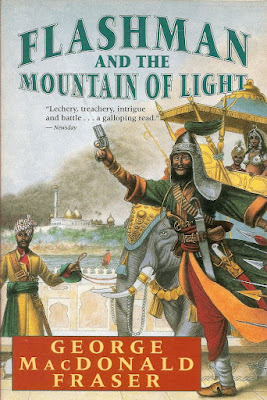
Flashman and the Mountain of Light by George MacDonald Fraser A+
After last month's two books set in India/Burma in the 1840’s, and with none of myfree books I had on hand appealing to me, I selected this Flashman book off myshelf to reread. Truly, this book is an order of magnitude betterthan those two previous historical fiction books set in India and Burma, Sands of Truth and Windrush. Fraser really knows how to write, and becausehe writes in the first person, he can showcase his vastlyentertaining skill with words by having them “written” by thecentral character of the story, Flashman, which makes the character himself all themore entertaining.
What I mean by thisis that when a writer had a distinctive voice – think of Chandleror Wodehouse – their writing risks overshadowing the story when written in third person, as theirdistinctive style can insert the writer between the story theyare telling and the reader, perhaps outshining the story being told.In some cases, this might be the author’s intent. But if not, by using afirst person narrator, their wit and styles becomes that of the character and comes from within the story – fleshing him or her out as they tell their story, in their style, keeping the storyitself in the fore.
ThisFlashman story set in 1845-46 India. Flashman is sent as a secret agent toPunjab city Lahore in the guise of an attorney to settle the questionof who is entitled to a treasure held by a British bank. The Punab isruled by a child, with his drunken and luscious mother, as regent. The Punjab has a large, European trained army that is itching to drive theBritish from India, waiting only for an excuse. Fraser seamlesslyinserts his (anti)hero, Flashman in to an extensively researched historical event, the first Punjab War –which includes footnotes highlighting the various historical events and people. The two book covers suggest something of how Flashman fits in to history. This combining fiction with real history facts and facets that are often too unbelievable to befiction, makes for both entertaining and educational history. This is the way I like my history. Highly recommended.
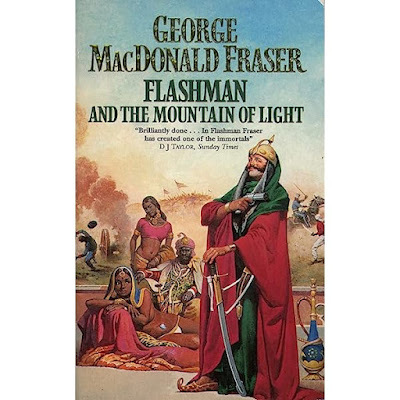
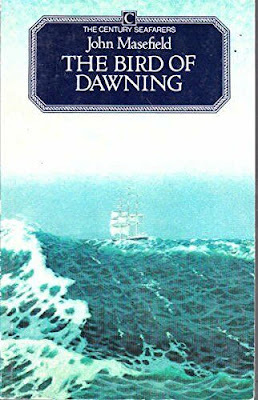
The Bird of Dawning by John Masefield C+
This is a sea story written by a fairly well known British author, first published in 1933. At the age of 15 in 1893, Masefield went to sea as an apprentice in a Cape Horn windjammer. He became ill in Chile and abandoned the sea, working at odd jobs in the U.S. before returning to London in 1897 to become literary editor of the Speaker. He went on to publish many books of novels, prose, and poetry until his death in 1967.
The novel is set on a tea clipper in the late 1860's, a time when tea clippers raced from China to London with the new crop of tea. A time when hard nosed Scottish ship owners would spend a fortune building fast, yacht like sailing ships, manned by large crews, hard-driving captains, especially designed to bring the first crop of tea each year from China to London in the least amount of time. In the Great Tea Race of 1866, five ships arrived in London within three days, the leading three ships within hours of each other after a voyage of 99 days from the far side of the world. I came across Basil Lubbock's The Tea Clippers while exploring the stacks of the University of Wisconsin Library while in college, and fell in love with the romance of tea clippers and the sea stories he told of their exploits over the decade or so of their brief heyday until steamships and the Suez Canal replaced them.
This novel is a fictional account of a tea clipper that is struck on a foul night by a steam ship, It sinks, leaving 16 survivors in an ill provisioned boat in the middle of the Atlantic ocean. Having been trained as a sailor, Masefield writes about their plight and the measures taken to deal with their situation in extensive detail, probably more than most casual reader would need, or care to know. Even I found it so, plus shipwreck survivors in a small boat is not one of my favorite tropes. It does, however have some twists and turns, that I won't spoil and ends with an exciting race; a fictional account similar to the ending that Great Tea Race of 1866 that I mentioned, which lifts it up from a simple C to a C+.
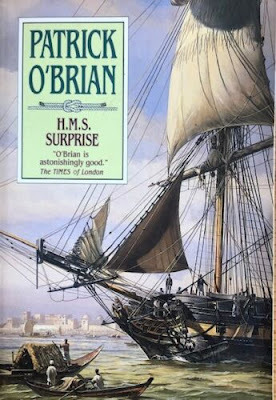
H. M. S. Surprise byPatrick O’Brian A+
Iwritten about how much I admire the writing style of Raymond Chandler,P. G. Wodehouse, and George MacDonald Fraser, and I do, but thewriting style of Patrick O’Brian is, in my opinion, every bit theirequal, though subtler. His writing style is very different than theseothers, and though his style may take a little getting used to, itis every bit as clever and delightful, while being perhaps more insightful and literary. Though it is written in a modern, if unique style, it iswritten in such a way as to suggest the period of which the novel isset. Found families are a trope these days, and a ship's crew in the days of sail is very much a found family. The books feature many shipmates who follow their captain from ship to ship, so that the stories are filled with both old friends as well as new characters, unique for each story. His books are a perfect blend of great literature and excitinggenre fiction, fiction that in the 21 book series takes the readeraround the early 19th century world, several times over, with many unexpected events and interesting ports of call.
Thisis the third book in the series. I’ve read all but the last twoor three books at least twice and probably three times, so Icould just pick this title off the shelf to read, knowing where Iwas in the saga. Not only is this one perhaps my favorite, but it takes us to India,something of a theme these last two months.
The story openswith Captain Jack Aubrey in temporary command of the frigateLively while the ship’s captain, a member of parliament is sittingwith parliament. They are on tedious blockade duty in the Med, keeping an eye aFrench fleet in harbor. He is ordered home to return the ship to itscaptain, and to stop along the way to pick up his best friend,Stephen Maturin, who, though he usually sails with Aubrey as the ship’s surgeon, is also a volunteer secret agent for the British. Maturin had gone tothe Spanish/French controlled island of Minorca to meet with Spanishresistance groups. However, it had been leaked to the French that Maturinmight be a spy, and so they had taken him into custody. Aubrey must rescue him in a daring night raid. After this episode, in order to“rehabilitate” Maturin, i.e. to make the French think they made amistake about him being a spy, he is to be sent as an aide to a diplomat bound forKampong in Indochina. Being very well regarded by the boss of British navalintelligence, and knowing that Captain Aubrey is aware of thissecond, secret occupation, Aubrey is appointed captain of thefrigate, Surprise, that will carry the diplomat to Kampong. The story then relatesvarious incidents at sea during the long voyage, first to Bombay. In India the ship is refitted after a harrowing passage southof the Cape of Good Hope, giving us a taste of India. And when they sail on to Kampong, they eventually come upon a French squadron consisting of a ship of the line and several frigates that have been sent to the India Ocean to disrupt British trade. This leads to a sea battle in between the French squadron and the East India Company's yearly convoy of large merchant ships bringing a vast quantity of tea and good from China to London, aided by the Surprise.
Theseries is best read in order, and though every book has its own story,there came a point where the series simply became one 21 volume novel. I have read other books of this period and in this sub-genre from a number of other writers including C. S. Forester, Alexander Kent, and Dudley Pope, and I can say that O'Brian's books stand head and shoulder above them, not only in writing, but in bringing in the world and society of the time period into his stories.
If you have any taste for historical fiction of this period and/or the sea, be sure to give Patrick O'Brian's Aubrey and Maturin books a try. I can not recommend them enough.
Coming up next week: Three cozy mystery/medical/monster urban fantasy books. Stay tuned.
June 28, 2023
What Next? (Writing)
 My writing desk, with Popeye "I Yam What I Yam" and my jar of tea candy. On the screen I have my usual two pages open when writing; my notes on the story to the left, the story itself to the right. Music being provided by Matthew Halsall & et.al (a radio mix) on YouTube music.
My writing desk, with Popeye "I Yam What I Yam" and my jar of tea candy. On the screen I have my usual two pages open when writing; my notes on the story to the left, the story itself to the right. Music being provided by Matthew Halsall & et.al (a radio mix) on YouTube music.Last, but not least,what can you expect to read from C Litka going forward? A goodquestion. Wish I knew the answer. I’ve never been one ofthose authors who have more story ideas than they have time to writethem. I don’t have notebooks full of ideas. And most importantly, Ineed an idea for a story that interests me so much that I not only want to spend months exploring and developing the idea in my head, shaping it into an actual story with interesting characters with original things to do, i.e. a plot, but then go on to spend months writing it down. Those ideas arerare. Plus, I don’t want to write the same story overand over again, so it has to be different enough from what I’vedone before for me to even want to write it.
Given all this, Ihaven’t done all that badly; having written and published 12novels 2 novellas, plus a short story in the last 15 years or so.Indeed, beginning in 2020 with The Prisoner of Cimlye, I’vewritten and published 7 books in the last three years. That’s apace I can’t maintain. Ideally, I plan to write and publish a booka year going forward. Ideally.
Right now my planned2024 novel is A Passage to Jarpara, thethird and final Tropic Sea story. Being the third book in aseries, only the people who liked The Prisoner of Cimlye are going to read it, so it has a relatively narrow market. I’ve beenworking on it off and on since last fall and have some 45K wordswritten in the first draft, probably more than halfway written.Indeed, I have only two major episodes, the connectingnarrative between them, and the conclusion to write. The major hang upis that I while I have a general idea what those episodes involve, Idon’t have a clue regarding the details or how to make themdifferent and interesting enough to make it worthwhile to write them.I hope it is just a matter of getting motivated. In any event, thiswill be a minor novel – a very self-indulgent, nostalgic story,written only because I like the characters and the locale and wanted to revisit them one last time. Plus, I feelobliged to get Taef Lang to his university post so that he can starthis long delayed career as an island archaeologist/historian. Thestory will be very episodic, really more of a travelogue than a novel. I’ve got 18 months to finish it. We’ll see.
I’ve exploredseveral other story ideas in the meantime.
I spent a great deal of time thinking about a fantasy(ish) novel. It would've been a hidden SF novel, as the "magic" would have used the advanced science = magic trope. It would feature a colony of Earth, like in Sailing to Redoubt, that has, perhaps deliberately made the settling of the planet into a founding myth, describing the advanced technology of the Founders as "magic" and outlawing it. But not all of this banned "magic" was forgotten, and indeed, the richest and most powerful families have secretly used various forms of this banned technology to maintain their influence and wealth. Our narrator would be a member of one such but a very modest family, who inherits a mansion from his great grandfather after the grandfather has been missing and declared dead. He discovers that the "ghost" of the grandfather still resides in the abandoned mansion, and that his grandfather may have been murdered, though the ghost can not say for certain... The female lead would be a woman who so nondescript, so ordinary looking and dressing that she is virtually invisible in the art show openings that she and the narrator both attend, making her extra-ordinary. Together they would solve the mystery. As with this, and the other story ideas below, the devil is in the plot, not the setting. I have to come up with a mystery story that would new and interesting, at least to me, and that has proven to be very hard. I shelved the idea for now.
Another story idea I've explored, one that I mentioned in my Marchupdate, is that of a portal fantasy novella. The idea sprang from onevening I experienced many years ago. It was spring, I was in collegeand it was exam time. I took a break from studying to take a longwalk in the falling evening, and for some reason, that walk feltsomehow enchanted – remembered and never duplicated. Nothingspecial happened, it was no doubt just a state of mind. But I thoughthat perhaps I could use that experience, along with a girl I noticedon one of my virtual bus trips through London, to make a story of anenchanted evening that was more than a state of mind. But I’ve yetto come up with a plot that works, nor a setting that issignificantly different enough from a thousand other stories thattake readers to fairyland to justify putting it into words. I am notoptimistic.
I’m also thinkingabout a story along the lines of what I’ve been reading recently,which is to say light novels by Molly Clavering and Ruby Ferguson setin Scotland of the 30’s & 40’s. These stories are delightfullittle stories of domestic life in what is now a bygone age. I don’think I could write the same type of story, but I do like reading“small” stories of everyday life, and I like to try my hand atit. I would use post-Storms Scotland which I set A Summer in Amberin as my setting, though I wouldn’t use the same characters. My currently version has a bachelor in his late 50’sretiring in a small Scottish town and… well there’s where theidea peters out at the moment.
A new idea has occurred to me; setting the story I just mentioned in post-storm London, and then using a version of the characters I had developed for the first story I mentioned, though once again, I would have to invent a new plot as it would not involve magic of any kind. Combining story ideas seems to be my go to method of getting stories to work these days. We’ll see what, if anythingdevelops.
The bottom line is that Iwrite for pleasure. I like to do it everyday. Since no one has hired me to write, no one owes me any money for mywritings, which is one reason why I share rather than sell my stories.However, the reverse is also true; no one has hired me to write astory, so I don’t owe anyone a story. If writing stories turns into work, Iwon’t write them. And if I can’t come up with a story that I want towrite, I won’t lose any sleep over not writing one. So while I can semi-promise A Passage toJarpara, for sometime in 2024, beyond that, only time will tell.
On a more positivenote, I still enjoy writing these posts, and I’m planning to continue to write and post pieces on this blog everyWednesday. (It's such a 2010 thing to do, you know.) In addition, I’ve just launched a new series, TheSaturday Morning Post, to be released every, you guessed it, Saturdaymorning. It will feature my book reviews. This means that my Wednesday post will most likely be about something otherthan the books I’ve read. I still love to write, and if I can't dream upstories to write, I can find other things of interest towrite about. (Fingers crossed.) The idea behind a writer’s blogsisn’t primarily to sell books, but to pull back the curtain alittle on the person behind the writing, so that you – dear readers– have an opportunity to get to know a writer as a personone way or another. I’ll keep that in mind when coming up withpieces to post. And, as always, I’ll remind you that I welcomecomments and emails from you.
